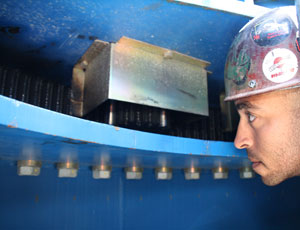“In the past, when technicians [went] out to inspect a crane, they [had] a paper report that they fill[ed] out, and basically it’s filed away,” Hall says, adding that JE Dunn inspects its tower cranes every six weeks or 300 hours. Federal guidelines require annual inspections. The company also performs nondestructive testing of the structure after each project.

JE Dunn uses a software program called DB02 to track its safety compliance. In 2008, it asked the San Carlos, Calif.-based supplier to retool the program around the hoisting fleet. “We can pull statistics and data, everything from fall protection to crane inspection,” Hall says. “Once a crane is moved, those statistics. . .follow that crane to the next job.”
The equipment is hooked up to mobile GPS trackers, too. That may sound especially strange for tower cranes—which typically work from a stationary position. But the tracking devices monitor essential data points, such as load testing. Everyday, JE Dunn requires its operators as part of their startup routine to test the crane to 110% capacity. Industry standards only require this procedure upon initial erection of the crane.
It works like this: The operator instructs a rigger on the ground to hook up a dedicated test block that weighs the same at the crane’s maximum rating. Tethered to it is a smaller, “pup” weight that adds on 10% more. The operator lifts the test weight, and when the chains pull tight on the pup, the crane’s limit switch trips, shutting it down. If not, the operator knows something is wrong. This method is controversial because it potentially exposes the crane to premature fatigue. But it is perfectly legal as long as the manufacturer does not prohibit it. Operators say they like the assurance: “If anything [bad] happened, it would be on me,” says Terry Pierce, a crane operator for JE Dunn. “You don’t get any second chances.”
E-mails fire away to Hall’s staff whenever a switch is tripped—so they know if an operator does not perform daily load tests. “When the contact goes in, it sends a signal to the GPS system,” Hague says. Technicians are the only people allowed to adjust the switches, which are calibrated for every job. If an operator tries to cheat, Hall says, “It’s an automatic no-questions-asked. . . that operator is dismissed within the hour.”
Tagged OuttWith 550 machines, Morrow is believed to run the largest rental fleet of tower cranes in the U.S. But even so, Morrow’s management team says the company could be doing more to improve safety.
“We have to change as an industry,” explains Juhren, who also chairs the American National Standards Institute’s B30.3 committee on tower cranes, which publishes best practices for these machines. “For years, it was just assumed that we did what we said we had to do.”
Years ago, Morrow already had developed a quality-control program—an internal mechanism for tracking its crane parts. “But we never really had a QA program,” says Juhren. In 2008, the company developed a system of tags—blue, red and green—that inspectors must sign and date. Blue means the part has been visually inspected and is ready for further tests. Red means it failed an inspection or test. Green means it is safe and ready to ship to a job.


Post a comment to this article
Report Abusive Comment